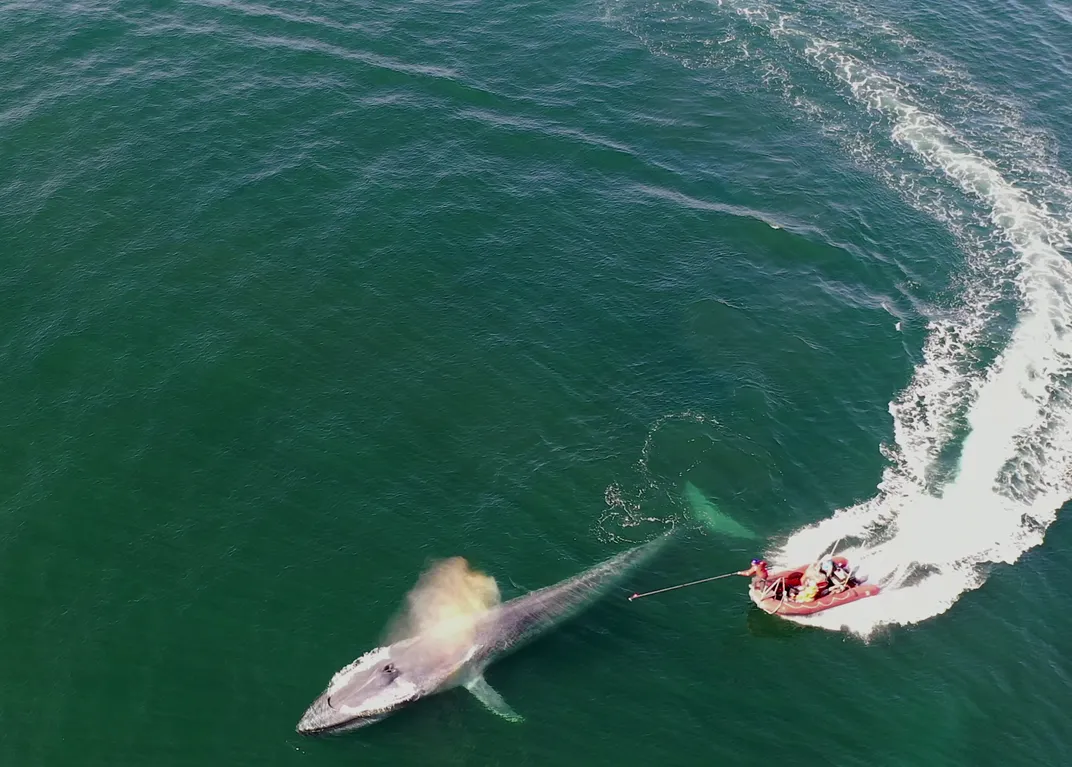Whales Are the Biggest Animals to Ever Exist—Why Aren’t They Bigger?
New research highlights the role diet plays in dictating a cetacean’s size
/https://tf-cmsv2-smithsonianmag-media.s3.amazonaws.com/filer/12/91/12911965-7838-490d-b7cf-50e9ec3b7240/218947.jpeg)
Pound for pound, the blue whale’s reign is indisputable. At around 100 feet long and 100 tons in size, these marine giants are the largest creatures—dead or alive—known to humankind.
Whales evolved from terrestrial ancestors that were dog-sized and lived on land some 50 million years ago. Over time, their size has grown 10,000-fold. Dinosaurs might have been longer, but they were not heavier by any stretch of the imagination, notes Nicholas Pyenson, curator of fossil marine mammals at the Smithsonian's National Museum of Natural History.
“We are living in the age of ocean giants,” says Pyenson. “Never in the history of life on Earth [have there] been larger animals in the ocean.”
Perhaps, then, it’s all the more baffling that the diets of the largest creatures to ever live consist of little more than nature’s nibbles—tiny, two-inch-long krill. But now, Pyenson and his colleagues have found that this menu of miniatures may have helped, rather than hindered, whales along their evolutionary growth spurt.
By attaching sophisticated sensors to a cadre of 300 whales while they dove for food, the researchers discovered that, by and large, diet dictates the size a whale ultimately achieves. And, as they report this week in the journal Science, that constraint works both ways: The amount of stuff whales shovel down their gullets can bulk them up—but it also limits just how big they can eventually get.
In the study, the researchers suction-cupped their sensors onto the backs of 13 species of both baleen and toothed whales, including porpoises and dolphins of various sizes, allowing the team to track the animals’ underwater activities. With data pouring in from the tag’s pressure sensors, hydrophones, cameras and accelerometers, the team was able to track each animal’s movements and estimate how much energy it expended per dive. Pyenson and his colleagues then reverse-engineered the whales’ probable diets by surveying the surrounding waters with sonar and sifting through past records of cetacean stomach dissections.

Their findings, covering some 10,000 feeding events, spilled some sizable secrets.
For toothed whales like sperm whales, which use sonar to chase down and snare prey one at a time, being large can be an asset for deep dives. But as body size increases, whales get less caloric bang for their buck when hunting, meaning the ratio of calories eaten to calories burned declines. Some of the largest toothed whales, the team found, don’t even eat enough during a dive to compensate for the energy they spent getting there before they must return to the surface to breathe.
Ultimately, the energetic tradeoff caps toothed whales’ growth somewhere around the size of sperm whales, which reach 60 feet in length and clock in around 55 tons, Pyenson says. There simply isn’t enough big-bodied prey in the ocean to sustain hunters in a higher weight class.
Blue whales, however, easily shatter that ceiling with a different feeding strategy. As filter-feeding whales, these animals drop their jaws to let in huge amounts of water, then strain out their pint-sized prey through the sieve-like structures in their mouths. Their maws are so massive that these whales can process a quantity of liquid equivalent to 100 to 160 percent of their own body volume in a single gulp, the team found. Compared to the thrill of the hunt, the process doesn’t take a ton of energy. But when prey is abundant, one swallow can gift the whale about 10 million calories, reports Jonathan Lambert at Science News.
That’s a “huge bang for the buck,” study author Jeremy Goldbogen, a marine ecologist at Stanford University, tells Malcolm Ritter of the Associated Press. This strategy, wherein efficiency increases in lockstep with size, may help explain how filter-feeders ballooned over time.
Eventually, though, some other limitation forced that trend to peter out. It may have something to do with the density of krill, which waxes and wanes with the seasons, Goldbogen tells Ritter. Another possibility is physiological: Perhaps such a massive body can’t work much harder than it already does to process such a quantity of food, Terrie Williams, a marine ecologist at the University of California, Santa Cruz who was not involved in the study, writes in an accompanying perspective piece.
Despite their conspicuous size, much about these colossal carnivores remains unknown, Pyenson says. But what his team has hit on already speaks volumes about Earth’s biggest beasts. “This really underscores the great, amazing mysteries of whales today,” he says. “Any new data that we get will continually test these ideas.”
Rachael Lallensack contributed reporting to this article.
/https://tf-cmsv2-smithsonianmag-media.s3.amazonaws.com/accounts/headshot/10172852_10152012979290896_320129237_n.jpg)
/https://tf-cmsv2-smithsonianmag-media.s3.amazonaws.com/accounts/headshot/10172852_10152012979290896_320129237_n.jpg)